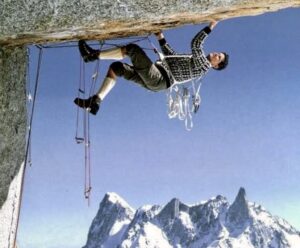Today, women around the world hold hands and flash smiles, and a flood of empowering, gender-sensitive messages swamp social media, covering us all in a sort of bright purple syrup, until midnight. Then, dear Cinderellas, everything goes back to normal.
It’s not that I don’t appreciate all the advances that have been opened for me as a woman in recent decades. I just think that women can be as nasty as men, so the treacly aspects of global sisterhood rub me the wrong way. If, for example, the handful of brave ladies who tackled the Alps in the 19th century proved anything, it was that they tried as hard and played as dirty as men to compete with each other to bag a first.

Women climbers in the 19th century.
Take the story of the second woman who summited Mont Blanc and claimed to be the first. Specifically, she cuttingly claimed to be the first woman to summit Mont Blanc who was “still capable of remembering her impressions”.
This proud and wealthy number two summiter, Henriette d’Angeville, was referring to a local Chamonix girl who had reached the coveted summit 30 years earlier in such a miserable state that all she could remember was that, “Everything around was white and down below was black.”
This poor pioneer, Marie Paradis, never had an interest in climbing. Some local guides convinced her to accompany them, promising fame and glory if she summited. Which she sort of did. Witnesses alleged that on the way up, she suffered from faints, nervous breakdowns, then lack of breath, and dizziness. In the end, the guides dragged and sometimes carried her up the higher slopes to the tippy-top.
Afterward, she was known Marie of Mont Blanc but otherwise, she remained as far away from fame and fortune as she had ever been.
No wonder that the cosmopolitan Henriette d’Angeville felt compelled to do better. She prepared the expedition carefully, gathered enough supplies to hold a gala, and had a special, seven-kilo outfit tailored for the occasion, which included a bonnet with a veil…and a boa!
Mark Twain, never one to pull his punches, described d’Angeville’s exotic climbing outfit in his book, A Tramp Abroad: “Miss d’Angeville put on a pair of men’s pantaloons to climb it, which was wise; but she cramped their utility by adding her petticoat, which was idiotic.”

Henriette d’Angeville dressed, as Mark Twain put it, “for the act”.
Wise or not, d’Angeville fought her way up Mont Blanc. Even when she was about to faint from altitude-related dizziness (and the weight of her clothes?), she refused to be carried by the guides, so that she could later claim that she had gone up “unaided”.
When she was on the summit, lacking Instagram, she wrote some letters on the spot to friends. She also made her guides form a chair with their hands and she stood on top, thus making sure that she had been higher up than anyone else, man or woman, before.
Back in Chamonix, she taunted those who had made bets on what point of the climb she would surrender and retreat. Long after, she enjoyed trumpeting her victory to anyone she met, having — as Claire Elaine Engle puts it in her History of Mountaineering in the Alps — “a morbid passion for self-advertisement”.
While the hapless Marie never tried to climb any other mountain, Henriette actually became a regular mountaineer. She never married — she didn’t need to be financially supported — and perhaps with the time she saved from child-rearing and house-tending, climbed another 21 peaks through her long, healthy life.






